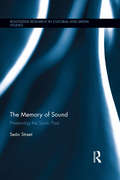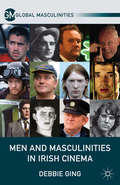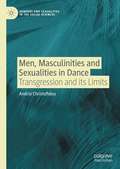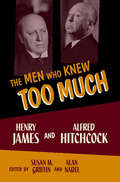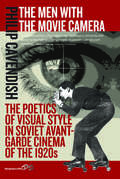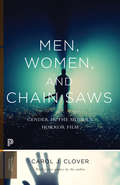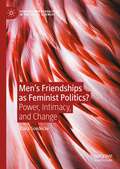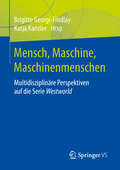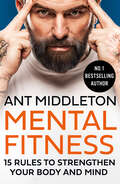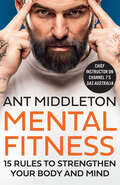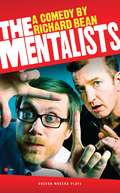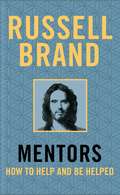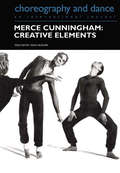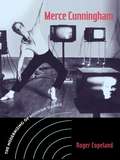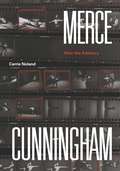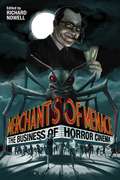- Table View
- List View
The Memory of Sound: Preserving the Sonic Past (Routledge Research in Cultural and Media Studies)
by Seán StreetThis book explores the connections between sound and memory across all electronic media, with a particular focus on radio. Street explores our capacity to remember through sound and how we can help ourselves preserve a sense of self through the continuity of memory. In so doing, he analyzes how the brain is triggered by the memory of programs, songs, and individual sounds. He then examines the growing importance of sound archives, community radio and current research using GPS technology for the history of place, as well as the potential for developing strategies to aid Alzheimer's and dementia patients through audio memory.
Men and Masculinities in Irish Cinema (Global Masculinities)
by D. GingSpanning a broad trajectory, from the New Gaelic Man of post-independence Ireland to the slick urban gangsters of contemporary productions, this study traces a significant shift from idealistic images of Irish manhood to a much more diverse and gender-politically ambiguous range of male identities on the Irish screen.
Men, Masculinities and Sexualities in Dance: Transgression and its Limits (Genders and Sexualities in the Social Sciences)
by Andria ChristofidouThis book examines men, masculinities and sexualities in Western theatrical dance, offering insights into the processes, actions and interactions that occur in dance institutions around gender-transgressive acts, and the factors that set limits to transgression. This text uses interview and observation data to analyze the conditions that encourage some boys and young men to become involved in this widely unconventional activity, and the ways through which they negotiate the gendered and sexual attachments of their professional identity. Most importantly, the book analyzes the opportunities male dancers find to develop a reflexive habitus, engage in gender transgressive acts and experiment with their sexuality. At the same time, it approaches gender and sexuality as embodied, and therefore as parts of identity that are not as easily amendable. This book will be of interest to scholars in Gender and Sexuality Studies as well as Dance and Performance Studies.
The Men Who Knew Too Much: Henry James and Alfred Hitchcock
by Susan M. Griffin Alan NadelHenry James and Alfred Hitchcock knew too much. Self-imposed exiles fully in the know, they approached American and European society as inside-outsiders, a position that afforded them a kind of double vision. Masters of their arts, manipulators of their audiences, prescient and pathbreaking in their techniques, these demanding and meticulous artists fiercely defended authorial and directorial control. Their fictions and films are obsessed with knowledge and its powers: who knows what? What is there to know? The Men Who Knew Too Much innovatively pairs these two greats, showing them to be at once classic and contemporary. Over a dozen major scholars and critics take up works by James and Hitchcock, in paired sets, to explore the often surprising ways that reading James helps us watch Hitchcock and what watching Hitchcock tells us about reading James. A wide-range of approaches offer fresh insights about spectatorship, narrative structure, and cinematic representation, as well as the relationship between technology and art, the powers of silence, sensory-and sensational-experiences, the impact of cognition, and the uncertainty of interpretation. The essays explore the avowal and disavowal of familial bonds, as well as questions of Victorian convention, female agency, and male anxiety. And they fruitfully engage issues related to patriarchy, colonialism, national, transnational, and global identities. The capacious collection, with its brilliant insights and intellectual surprises, is equally compelling in its range and cogency for James readers and film theorists, for Hitchcock fans and James scholars.
The Men Who Knew Too Much: Henry James and Alfred Hitchcock
by Alan Nadel Henry James and Alfred HitchcockHenry James and Alfred Hitchcock knew too much. Self-imposed exiles fully in the know, they approached American and European society as inside-outsiders, a position that afforded them a kind of double vision. Masters of their arts, manipulators of their audiences, prescient and pathbreaking in their techniques, these demanding and meticulous artists fiercely defended authorial and directorial control. Their fictions and films are obsessed with knowledge and its powers: who knows what? What is there to know? The Men Who Knew Too Much innovatively pairs these two greats, showing them to be at once classic and contemporary. Over a dozen major scholars and critics take up works by James and Hitchcock, in paired sets, to explore the often surprising ways that reading James helps us watch Hitchcock and what watching Hitchcock tells us about reading James. A wide-range of approaches offer fresh insights about spectatorship, narrative structure, and cinematic representation, as well as the relationship between technology and art, the powers of silence, sensory-and sensational-experiences, the impact of cognition, and the uncertainty of interpretation. The essays explore the avowal and disavowal of familial bonds, as well as questions of Victorian convention, female agency, and male anxiety. And they fruitfully engage issues related to patriarchy, colonialism, national, transnational, and global identities. The capacious collection, with its brilliant insights and intellectual surprises, is equally compelling in its range and cogency for James readers and film theorists, for Hitchcock fans and James scholars.
The Men with the Movie Camera: The Poetics of Visual Style in Soviet Avant-Garde Cinema of the 1920s
by Philip CavendishUnlike previous studies of the Soviet avant-garde during the silent era, which have regarded the works of the period as manifestations of directorial vision, this study emphasizes the collaborative principle at the heart of avant-garde filmmaking units and draws attention to the crucial role of camera operators in creating the visual style of the films, especially on the poetics of composition and lighting. In the Soviet Union of the 1920s and early 1930s, owing to the fetishization of the camera as an embodiment of modern technology, the cameraman was an iconic figure whose creative contribution was encouraged and respected. Drawing upon the film literature of the period, Philip Cavendish describes the culture of the camera operator, charts developments in the art of camera operation, and studies the mechanics of key director-cameraman partnerships. He offers detailed analysis of Soviet avant-garde films and draws comparisons between the visual aesthetics of these works and the modernist experiments taking place in the other spheres of the visual arts.
Men, Women, and Chain Saws: Gender in the Modern Horror Film
by Carol J. CloverFrom its first publication in 1992, Men, Women, and Chain Saws has offered a groundbreaking perspective on the creativity and influence of horror cinema since the mid-1970s. Investigating the popularity of the low-budget tradition, Carol Clover looks in particular at slasher, occult, and rape-revenge films. Although such movies have been traditionally understood as offering only sadistic pleasures to their mostly male audiences, Clover demonstrates that they align spectators not with the male tormentor, but with the females tormented—notably the slasher movie's "final girls"—as they endure fear and degradation before rising to save themselves. The lesson was not lost on the mainstream industry, which was soon turning out the formula in well-made thrillers.Including a new preface by the author, this Princeton Classics edition is a definitive work that has found an avid readership from students of film theory to major Hollywood filmmakers.
Men’s Friendships as Feminist Politics?: Power, Intimacy, and Change (Genders and Sexualities in the Social Sciences)
by Klara GoedeckeThis book discusses men’s friendships in relation to queer, discursive, and intersectional feminist theories. It analyses stories of intimacy, touch, hugs, and conversations, connecting these with current discussions within feminism and critical masculinity studies on “new” men, men’s political activism, and how friendships are lived and conceptualised in relation to heteronormative relationship ideals. Drawing on individual and dyadic interviews with middle-class Swedish men, all engaged in or sympathetic to feminist issues in some sense, this volume shows that Swedish gender equality ideologies as well as feminist, therapeutic, neo-liberal, and individualist discourses prevalent in the Western world structured the men’s friendships and their engagement with gender politics. Chapters cover friendship temporalities, gendered friendship ideals, friendship as men’s politics, and friendship as performed in interaction. Bridging the literatures of feminist research and friendship, the author points to tensions and contradictions in pro-feminist men’s political projects and in contemporary masculine positions.
Mensch, Maschine, Maschinenmenschen: Multidisziplinäre Perspektiven auf die Serie Westworld
by Brigitte Georgi-Findlay Katja KanzlerDieses Buch setzt sich mit der viel diskutierten HBO-Serie Westworld auseinander. Aus multidisziplinären Perspektiven fragen die Autor*innen danach, wie die Science-Fiction/Western-Serie als Erzählung funktioniert und dabei Aspekte des Posthumanismus, Fragen künstlicher Intelligenz und das Verhältnis von Mensch und Maschine problematisiert.
Mental Fitness: 15 Rules To Strengthen Your Body And Mind
by Ant MiddletonPRE-ORDER NOW The brilliant new book from the multiple Sunday Times bestselling author that will explain the principles behind maintaining a healthy mind and body.
Mental Fitness: 15 Rules To Strengthen Your Body And Mind
by Ant MiddletonPRE-ORDER NOW The brilliant new book from the multiple Sunday Times bestselling author that will explain the principles behind maintaining a healthy mind and body.
The Mentalists: The Mentalists - Under The Whaleback - The God Botherers (Modern Playwrights Ser.)
by Richard BeanA hotel room, a long-standing friendship and a hair raising plan! Holed up in a faceless Finsbury Park hotel room, Ted and Morrie are forced to confront the darker side of their unique relationship. Things unravel as the pressure mounts in this hilarious and touching tale of friendship and utopian visions gone awry.
Mentors: How to Help and be Helped
by Russell BrandCould happiness lie in helping others and being open to accepting help yourself?Mentors – the follow up to Sunday Times number one bestseller, Recovery – describes the benefits of seeking and offering help.‘I have mentors in every area of my life, as a comic, a dad, a recovering drug addict, a spiritual being and as a man who believes that we, as individuals and the great globe itself, are works in progress and that through a chain of mentorship we can improve individually and globally, together . . . One of the unexpected advantages my drug addiction granted is that the process of recovery that I practise includes a mentorship tradition.I will encourage you to find mentors of your own and explain how you may better use the ones you already have. Furthermore, I will tell you about my experiences mentoring others and how invaluable that has been on my ongoing journey to self-acceptance and how it has helped me to transform from a bewildered and volatile vagabond to a (mostly) present and (usually) focussed husband and father.’ – Russell BrandMentors: How to Help and Be Helped describes the impact that a series of significant people have had on the author – from the wayward youths he tried to emulate growing up in Essex, through the first ex-junkie sage, to the people he turns to today to help him be a better father. It explores how we all – consciously and unconsciously – choose guides, mentors and heroes throughout our lives and examines the new perspectives they can bring.
Merce Cunningham: Creative Elements (Choreography and Dance Studies Series #Vols. 4, Pts. 2.)
by Joan Acocella Elliot Caplan Marilyn Vaughan Drown William Fetterman John Holzaepfel Gordon Mumma Nelson Rivera Thecla Schiphorst David VaughanMerce Cunningham reached the age of 75 in 1994, an age at which many creative artists are content to rest on their laurels, or at least to leave behind whatever controversies they may have caused during their careers. No so Cunningham. In the first place, his 70s have been a time of intense creativity in which he has choreographed as many as four new works a year. Cunningham is a strongly committed as ever to the discovery of new ways of moving and of making movement, refusing to be hampered by the physical limitations that have come with age. Since 1991 every new work has been made at least in part with the use of the computer program Life Forms, which enables him to devise choreographic phrases that he himself would be unable to perform - and which challenge and develop the virtuosity of the young dancers in his company.The essays collected in this special issue of Choreography and Dance were written over the last few years and discuss various aspects of the work of Cunningham as seen both from the outside and the inside.
Merce Cunningham: The Modernizing of Modern Dance
by Roger CopelandFirst Published in 2004. Routledge is an imprint of Taylor & Francis, an informa company.
Merce Cunningham: The Modernizing of Modern Dance
by Roger CopelandFirst Published in 2004. Routledge is an imprint of Taylor & Francis, an informa company.
Merce Cunningham: After the Arbitrary
by Carrie NolandOne of the most influential choreographers of the twentieth century, Merce Cunningham is known for introducing chance to dance. Far too often, however, accounts of Cunningham’s work have neglected its full scope, focusing on his collaborations with the visionary composer John Cage or insisting that randomness was the singular goal of his choreography. In this book, the first dedicated to the complete arc of Cunningham’s career, Carrie Noland brings new insight to this transformative artist’s philosophy and work, providing a fresh perspective on his artistic process while exploring aspects of his choreographic practice never studied before. Examining a rich and previously unseen archive that includes photographs, film footage, and unpublished writing by Cunningham, Noland counters prior understandings of Cunningham’s influential embrace of the unintended, demonstrating that Cunningham in fact set limits on the role chance played in his dances. Drawing on Cunningham’s written and performed work, Noland reveals that Cunningham introduced variables before the chance procedure was applied and later shaped and modified the chance results. Chapters explore his relation not only to Cage, but also Marcel Duchamp, Robert Rauschenberg, James Joyce, and Bill T. Jones. Ultimately, Noland shows that Cunningham approached movement as more than “movement in itself,” and that his work enacted archetypal human dramas. This remarkable book will forever change our appreciation of the choreographer’s work and legacy.
Merce Cunningham: After the Arbitrary
by Carrie NolandOne of the most influential choreographers of the twentieth century, Merce Cunningham is known for introducing chance to dance. Far too often, however, accounts of Cunningham’s work have neglected its full scope, focusing on his collaborations with the visionary composer John Cage or insisting that randomness was the singular goal of his choreography. In this book, the first dedicated to the complete arc of Cunningham’s career, Carrie Noland brings new insight to this transformative artist’s philosophy and work, providing a fresh perspective on his artistic process while exploring aspects of his choreographic practice never studied before. Examining a rich and previously unseen archive that includes photographs, film footage, and unpublished writing by Cunningham, Noland counters prior understandings of Cunningham’s influential embrace of the unintended, demonstrating that Cunningham in fact set limits on the role chance played in his dances. Drawing on Cunningham’s written and performed work, Noland reveals that Cunningham introduced variables before the chance procedure was applied and later shaped and modified the chance results. Chapters explore his relation not only to Cage, but also Marcel Duchamp, Robert Rauschenberg, James Joyce, and Bill T. Jones. Ultimately, Noland shows that Cunningham approached movement as more than “movement in itself,” and that his work enacted archetypal human dramas. This remarkable book will forever change our appreciation of the choreographer’s work and legacy.
Merce Cunningham: After the Arbitrary
by Carrie NolandOne of the most influential choreographers of the twentieth century, Merce Cunningham is known for introducing chance to dance. Far too often, however, accounts of Cunningham’s work have neglected its full scope, focusing on his collaborations with the visionary composer John Cage or insisting that randomness was the singular goal of his choreography. In this book, the first dedicated to the complete arc of Cunningham’s career, Carrie Noland brings new insight to this transformative artist’s philosophy and work, providing a fresh perspective on his artistic process while exploring aspects of his choreographic practice never studied before. Examining a rich and previously unseen archive that includes photographs, film footage, and unpublished writing by Cunningham, Noland counters prior understandings of Cunningham’s influential embrace of the unintended, demonstrating that Cunningham in fact set limits on the role chance played in his dances. Drawing on Cunningham’s written and performed work, Noland reveals that Cunningham introduced variables before the chance procedure was applied and later shaped and modified the chance results. Chapters explore his relation not only to Cage, but also Marcel Duchamp, Robert Rauschenberg, James Joyce, and Bill T. Jones. Ultimately, Noland shows that Cunningham approached movement as more than “movement in itself,” and that his work enacted archetypal human dramas. This remarkable book will forever change our appreciation of the choreographer’s work and legacy.
Merce Cunningham: After the Arbitrary
by Carrie NolandOne of the most influential choreographers of the twentieth century, Merce Cunningham is known for introducing chance to dance. Far too often, however, accounts of Cunningham’s work have neglected its full scope, focusing on his collaborations with the visionary composer John Cage or insisting that randomness was the singular goal of his choreography. In this book, the first dedicated to the complete arc of Cunningham’s career, Carrie Noland brings new insight to this transformative artist’s philosophy and work, providing a fresh perspective on his artistic process while exploring aspects of his choreographic practice never studied before. Examining a rich and previously unseen archive that includes photographs, film footage, and unpublished writing by Cunningham, Noland counters prior understandings of Cunningham’s influential embrace of the unintended, demonstrating that Cunningham in fact set limits on the role chance played in his dances. Drawing on Cunningham’s written and performed work, Noland reveals that Cunningham introduced variables before the chance procedure was applied and later shaped and modified the chance results. Chapters explore his relation not only to Cage, but also Marcel Duchamp, Robert Rauschenberg, James Joyce, and Bill T. Jones. Ultimately, Noland shows that Cunningham approached movement as more than “movement in itself,” and that his work enacted archetypal human dramas. This remarkable book will forever change our appreciation of the choreographer’s work and legacy.
Merce Cunningham: After the Arbitrary
by Carrie NolandOne of the most influential choreographers of the twentieth century, Merce Cunningham is known for introducing chance to dance. Far too often, however, accounts of Cunningham’s work have neglected its full scope, focusing on his collaborations with the visionary composer John Cage or insisting that randomness was the singular goal of his choreography. In this book, the first dedicated to the complete arc of Cunningham’s career, Carrie Noland brings new insight to this transformative artist’s philosophy and work, providing a fresh perspective on his artistic process while exploring aspects of his choreographic practice never studied before. Examining a rich and previously unseen archive that includes photographs, film footage, and unpublished writing by Cunningham, Noland counters prior understandings of Cunningham’s influential embrace of the unintended, demonstrating that Cunningham in fact set limits on the role chance played in his dances. Drawing on Cunningham’s written and performed work, Noland reveals that Cunningham introduced variables before the chance procedure was applied and later shaped and modified the chance results. Chapters explore his relation not only to Cage, but also Marcel Duchamp, Robert Rauschenberg, James Joyce, and Bill T. Jones. Ultimately, Noland shows that Cunningham approached movement as more than “movement in itself,” and that his work enacted archetypal human dramas. This remarkable book will forever change our appreciation of the choreographer’s work and legacy.
Merce Cunningham: After the Arbitrary
by Carrie NolandOne of the most influential choreographers of the twentieth century, Merce Cunningham is known for introducing chance to dance. Far too often, however, accounts of Cunningham’s work have neglected its full scope, focusing on his collaborations with the visionary composer John Cage or insisting that randomness was the singular goal of his choreography. In this book, the first dedicated to the complete arc of Cunningham’s career, Carrie Noland brings new insight to this transformative artist’s philosophy and work, providing a fresh perspective on his artistic process while exploring aspects of his choreographic practice never studied before. Examining a rich and previously unseen archive that includes photographs, film footage, and unpublished writing by Cunningham, Noland counters prior understandings of Cunningham’s influential embrace of the unintended, demonstrating that Cunningham in fact set limits on the role chance played in his dances. Drawing on Cunningham’s written and performed work, Noland reveals that Cunningham introduced variables before the chance procedure was applied and later shaped and modified the chance results. Chapters explore his relation not only to Cage, but also Marcel Duchamp, Robert Rauschenberg, James Joyce, and Bill T. Jones. Ultimately, Noland shows that Cunningham approached movement as more than “movement in itself,” and that his work enacted archetypal human dramas. This remarkable book will forever change our appreciation of the choreographer’s work and legacy.
Merce Cunningham: Creative Elements (Choreography and Dance Studies Series)
by David VaughanMerce Cunningham reached the age of 75 in 1994, an age at which many creative artists are content to rest on their laurels, or at least to leave behind whatever controversies they may have caused during their careers. No so Cunningham. In the first place, his 70s have been a time of intense creativity in which he has choreographed as many as four new works a year. Cunningham is a strongly committed as ever to the discovery of new ways of moving and of making movement, refusing to be hampered by the physical limitations that have come with age. Since 1991 every new work has been made at least in part with the use of the computer program Life Forms, which enables him to devise choreographic phrases that he himself would be unable to perform - and which challenge and develop the virtuosity of the young dancers in his company.The essays collected in this special issue of Choreography and Dance were written over the last few years and discuss various aspects of the work of Cunningham as seen both from the outside and the inside.
Merchants of Menace: The Business of Horror Cinema
by Richard NowellEven though horror has been a key component of media output for almost a century, the genre's industrial character remains under explored and poorly understood. Merchants of Menace: The Business of Horror Cinema responds to a major void in film history by shedding much-needed new light on the economic dimensions of one of the world's most enduring audiovisual forms. Given horror cuts across budgetary categories, industry sectors, national film cultures, and media, Merchants of Menace also promises to expand understandings of the economics of cinema generally. Covering 1930-present, this groundbreaking collection boasts fourteen original chapters from world-leading experts taking as their focus such diverse topics as early zombie pictures, post-WWII chillers, Civil Rights-Era marketing, Hollywood literary adaptations, Australian exploitation, "torture-porn" Auteurs, and twenty-first-century remakes.
Merchants of Menace: The Business of Horror Cinema
by Richard NowellEven though horror has been a key component of media output for almost a century, the genre's industrial character remains under explored and poorly understood. Merchants of Menace: The Business of Horror Cinema responds to a major void in film history by shedding much-needed new light on the economic dimensions of one of the world's most enduring audiovisual forms. Given horror cuts across budgetary categories, industry sectors, national film cultures, and media, Merchants of Menace also promises to expand understandings of the economics of cinema generally. Covering 1930-present, this groundbreaking collection boasts fourteen original chapters from world-leading experts taking as their focus such diverse topics as early zombie pictures, post-WWII chillers, Civil Rights-Era marketing, Hollywood literary adaptations, Australian exploitation, "torture-porn" Auteurs, and twenty-first-century remakes.
